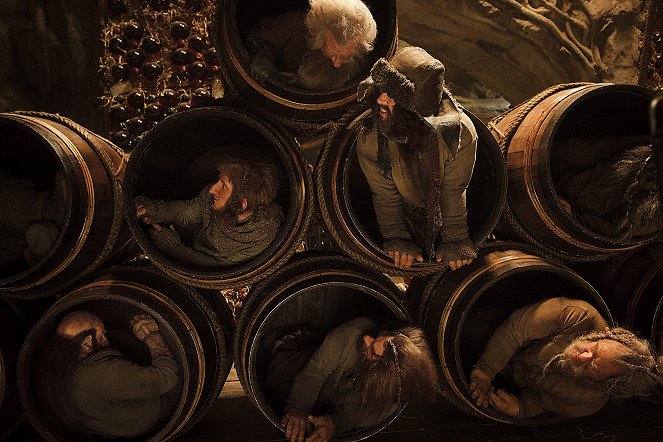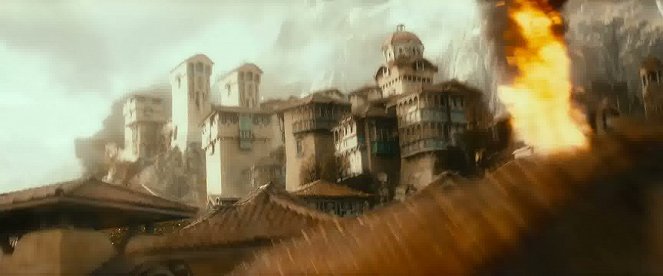Directed by:
Peter JacksonCinematography:
Andrew LesnieComposer:
Howard ShoreCast:
Martin Freeman, Ian McKellen, Benedict Cumberbatch, Luke Evans, Orlando Bloom, Evangeline Lilly, Richard Armitage, Graham McTavish, James Nesbitt, Ken Stott (more)VOD (4)
Plots(1)
The film continues the adventure of the title character Bilbo Baggins as he journeys with the Wizard Gandalf and thirteen Dwarves, led by Thorin Oakenshield, on an epic quest to reclaim the lost Dwarf Kingdom of Erebor. Having survived the beginning of their unexpected journey, the Company continues East, encountering along the way the skin-changer Beorn and a swarm of giant Spiders in the treacherous Mirkwood Forest. After escaping capture by the dangerous Woodland Elves, the Dwarves journey to Lake-town, and finally to the Lonely Mountain itself, where they must face the greatest danger of all — a creature more terrifying than any before, which will test not only the depth of their courage but the limits of their friendship and the wisdom of the journey itself — the Dragon Smaug. (official distributor synopsis)
(more)Videos (26)
Reviews (14)
To accuse Peter Jackson – as many here do – of getting too carried away and overwhelming us with attractions is to misunderstand his essence. The truth is that he hasn't changed at all since he was a young boy baking evil alien masks in his mother's oven for his feature debut. He’s a big child who loves movie effects and likes to impress with visual stunts that often go over the edge. I’ve thoroughly enjoyed the overstuffed King Kong, and I’ve also enjoyed the overstuffed second Hobbit. It’s so visually sumptuous and rich that no other fantasy or fairytale movie of the last ten years can match it in this respect. It starts to make sense if you take the lukewarm first film as a launching pad of sorts for the massive second part. But at the same time, I warn you, if you are you looking for insightful ideas, eye-popping scenes, in short, that "humanly warm artistic experience", go elsewhere. If, on the contrary, you want Jackson off the chains and as his most exuberant self, you are in the right place.
()
Well, the magic is gone. Thanks to its slower pace, the first Hobbit put me on a wave of nostalgia, but this one is just disappointing, with uninteresting characters that you never get to know anything about and a heap of awful digital mess that in a couple of scenes (e.g. Legolas jumping on the heads of the dwarves) reminded me of the infamous car chase in the jungle of the fourth Indiana Jones. Gandalf’s search is utterly pointless, Legolas is an ornament, the love story between Kate from Lost and the second (and also the last) recognisable dwarf out of thirteen (defined with the word “annoyed”) is stupid and, on top of that, the wanderings of the party of dwarves and Bilbo pulled me into a deep confused astonishment (to send a Hobbit into a mountain to dig into drifts of gold and find some kind of powerful stone that could be anywhere, hoping the dragon won’t wake up, it’s a really great plan that may be fine for a children fairy-tale, like the book, but in a movie that wants to be dark fantasy feels out of place, at the very least). Also, there‘s no proper story or dramatic arc (the first one worked with Bilbo being accepted into the group and gaining the trust of the dwarves), so if the plot of the first part could be summarised, with some exaggeration, with “they left”, here “they arrived” is enough without any exaggeration; and with the impression that in the third “they will be there for awhile”. Jackson still has a firm hand, but my disappointment won’t let me give more than two stars to a film that terribly bored me with its barrage of digital gimmicks.
()
I will no longer cry over spilled milk, i.e., that the division into three films does not make sense (but it still doesn't). For the first few tens of minutes, a digital cup of part one spreads across the screen with a sunset / sunrise sprouted behind it. I remember with love the times when Middle-earth was more material and objective for me than the digital figures of orcs and the magnificent play of colors. Jackson stuffs wherever he can. I hope he grows antlers for the elven travesty show. Tauriel is beautiful and annoying, Legolas seems half a century older than in The Lord of the Rings and because he can't be the more casual athlete who actually likes dwarves, he pretends to be a shepherd whose flock of sheep has been sodomized (hello Znojmo) and his contribution lies in spiral choreographies (which is really annoying at the end). For me, the second film is divided by the scene with the barrels. The liquid action voyage is divine, and with the arrival of Bard and Esgaroth, I once again get the feeling that I want to be a part of The Hobbit and engage in it in some way other than just by staring at it. The conflict between the demonically blooming Thorin and the charismatic rioter Bard has an old nobility, and the disgusting sub-grave bourgeois mayor returns to The Hobbit a piece of overlap and humorous theater. Suddenly there is something to discover and something to be surprised and amused by ("why are dwarves crawling out of the toilets?"). The feeling that I was really looking forward to the three-leafed narrative lines intersecting in the grand action finale at the end gradually left me. Smaug is interrupted by a sad love-funeral episode with Kili, and I can't say that I would enjoy watching the stretched part of Kahan's melter in the Misty Mountain. In addition, the final triple cliffhanger is pretty cheap and ruined my assumption that the second film is better structured than the first. So, just like last time. This time even closer to four stars, but given those disappointed expectations... no. No way. Edit after the second watch: Ok, fine.
()
Since the first part of The Hobbit trilogy was one long exposition, the second part doesn’t have to spend any time on introducing the main characters and explaining their motivations, so it is unconstrained in telling its story. The livelier and more focused (though again episodic) narrative lacks a satisfying conclusion. Instead of bringing at least some of the storylines to a close in the climax, The Desolation of Smaug ends with just another complication. ___ Smaug seems like an episode of an epic fantasy series or an RPG, but one played by someone else who definitely isn’t going to skip any cut-scenes. Like in role-playing games, we have before us a group of adventurers who gain new experience through encounters with increasingly powerful enemies and then ultimately come face-to-face with the ultimate boss (who, of course, can’t be killed in conventional combat). In retrospect, one gets the impression that the main objective of the narrative was always the confrontation with the dragon, because nothing else actually happens in the film. Though again long and never as clear as anything done by Spielberg (whose Tintin is brought to mind by the whitewater ride), the action sequences are not there solely for their own sake. Rather, they serve for developing the already known characters (Bilbo becomes a bigger hero and more dependent on the ring), for introducing (old-)new characters (Legolas, Tauriel) and for demonstrating the courage of young, uprooted and seemingly powerless peoples to stand up to a great enemy, which I believe was an important motif for Tolkien, given the era in which he wrote his books. ___ The creative rendering of Middle Earth is also like that of a video game, as CGI animation is used to a greater extent than the authentic New Zealand landscape. The bookish illustrations would have been captivating and I could have looked at them for tens of minutes, but when combined with live-action characters, the setting seems artificial. Not to mention the Orcs, which were apparently copied directly from action-adventure games like God of War (the ease with which the goblin warriors are decapitated would seem to correspond to their video-game origins). ___ The characters whom the protagonists encounter on their journey mostly serve to impart valuable information to the adventurers or provide asylum and weaponry. Take, for example, Beorn. Though he will most likely appear in The Battle of the Five Armies, he is used rather purposefully in The Desolation of Smaug. Conversely, the mayor of Esgaroth, attaining prosperity at the cost of his citizens’ freedom, comes across merely as a dubious attempt to update the narrative with allusions to the current corruption of politics. It is necessary to acknowledge that Jackson managed to justify the presence here of other characters (Azog, Radagast) on whom seemingly needless attention was focused in An Unexpected Journey. It similarly becomes apparent why we had to find out that Bilbo is good at riddles (discovery of the keyhole). ___ The motif of the lost home is weakened, as its bearers are more or less only dwarves, not Bilbo, who is newly obsessed mainly with his ring. I believe that we spent the first forty minutes of An Unexpected Journey in Hobbiton for the sake of the possibility to use the contrast between the Hobbit’s previous comfort and his current discomfort. What came to be the key motif was the egocentrism of whole peoples (elves) and individuals (Thorin) and greed personified by Smaug, which is by far the most well-written character of the entire film. ___ The Desolation of Smaug gains momentum as the linear narrative branches into two and then three storylines. Thanks to that, the final act is as dynamic as the sweeping action sequences in Nolan’s films (though Jackson cuts between individual action scenes with greater deliberation) and, at the same time, emotionally engaging because at least in Tauriel’s case, we do not know what fate awaits her (though because she is an elf, she cannot die). The proliferation of the final confrontations with evil testifies to Jackson’s concept of The Hobbit not as the adventure of a single hero, but as an “ensemble piece”. For a team-oriented action movie in which particularly the abilities of the individual characters and their contribution to the accomplishment of the mission(s) are important (see the exemplary cooperation between Bilbo and the dwarves in the climax), it is hard to criticise the film for its emotional coldness and indifference toward individual characters. At any rate, I don’t find it pleasing, as I believe that many of those involved would deserve a separate film. ___ From the perspective of satisfying storytelling, the doubly open-ended (i.e. without a beginning or an end) The Desolation of Smaug is far from being a useless film. Thanks to the logistically flawless introduction of new characters and changing settings, it holds our attention, but it doesn’t hold up as a stand-alone story. The Desolation of Smaug does a better job than the good-natured An Unexpected Journey of giving the impression that “something” sinister is in the air. At the same time, however, it doesn’t have enough material to fully tell a story and, though it looks like a lively action experience from the outside, it paradoxically spends most of its runtime just treading water. 75%
()
(less)
(more)
It’s a whole class better than the first film. Jackson tames mostly himself, puts together a somewhat coherent plot, albeit with a slight aftertaste of forced intermezzo, and above all gives credit to the winged lizard. The dragon has no equal in the ring of digital monsters and thus irons out, in the end, the embarrassing impressions of otherwise rather dull (Beorn) and completely useless (Tauriel) characters.
()
Gallery (254)
Photo © New Line Cinema, Metro-Goldwyn-Mayer, Warner Bros. Pictures / Mark Pokorny



Ads